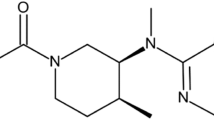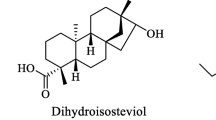Abstract
Purpose. A pharmacokinetic study was carried out in rats to investigate the effect of arthritis on the glucuronidation of the nonsteroidal anti-inflammatory drug ketoprofen.
Methods. An iv bolus dose of R,S-ketoprofen (10 mg/kg) was administered to control (n = 6) and adjuvant-induced arthritic rats (n = 6). All experiments were carried out in bile-exteriorized animals. Concentrations of R- and S-ketoprofen in plasma, bile and urine, and of their glucuronides in bile and urine were determined by HPLC. In a separate series of experiments, the ex vivo plasma protein binding of R- and S-ketoprofen was measured in control and arthritic rats following iv administration of R,S-ketoprofen.
Results. As a result of a significant decrease in plasma albumin concentrations in arthritic rats, the unbound fraction of R- and S-ketoprofen was significantly increased (approximately 2-fold) in rats with adjuvant-induced arthritis. Total (i.e., bound plus unbound) plasma clearances of R- and S-ketoprofen were not different in arthritic rats. Unbound plasma clearances of both ketoprofen enantiomers, however, were significantly reduced (by 53% and 61%, respectively). This was due to a significant impairment in the formation of the R- and S-ketoprofen glucuronides. There was no apparent effect of adjuvant-induced arthritis on the chiral inversion of R- to S-ketoprofen.
Conclusions. Adjuvant-induced arthritis in the rat leads to a significant impairment in the in vivo glucuronidation of R- and S-ketoprofen.
Similar content being viewed by others
REFERENCES
M. W. Whitehouse. Adjuvant-induced polyarthritis in rats. In “Handbook of Animal Models for the Rheumatic Diseases”, vol I (Eds. R. Greenwald and H. Diamond), CRC Press, Boca Raton, pp. 3–16, 1988.
B. M. Weichman. Rat adjuvant arthritis: a model of chronic inflammation. In “Pharmacological Methods in the Control of Inflammation” (Eds. J. Y. Chang and A. J. Lewis), Alan R. Liss, Inc., New York, pp. 363–380, 1989.
K. A. Walker, H. E. Barber, and G. M. Hawksworth. Mechanism responsible for altered propranolol disposition in adjuvant-induced arthritis in the rat. Drug Metab. Disp. 14:482–486 (1986).
S. H. Pollock, H. W. Matthews, and M. J. D'Souza. Pharmacokinetic analysis of cyclosporine in adjuvant arthritic rats. Drug Metab. Disp. 17:595–599 (1989).
M. Piquette-Miller and F. Jamali. Effect of adjuvant arthritis on the disposition of acebutolol enantiomers in rats. Agents Actions 37:290–296 (1992).
M. Piquette-Miller and F. Jamali. Influence of severity of inflammation on the disposition kinetics of propranolol enantiomers in ketoprofen-treated and untreated adjuvant arthritis. Drug Metab. Disp. 23:240–245 (1995).
A. Toda, N. Ishii, T. Kihara, A. Nagamatsu, and H. Shimeno. Effect of adjuvant-induced arthritis on hepatic drug metabolism in rats. Xenobiotica 26:603–611 (1994).
C. J. Meunier and R. K. Verbeeck. Glucuronidation of R-and S-ketoprofen, acetaminophen and diflunisal by liver microsomes of adjuvant-induced arthritic rats. Drug Metab. Disp. 27:26–31 (1999).
F. M. Brunelle and R. K. Verbeeck. Conjugation-deconjugation cycling of diflunisal via β-glucuronidase catalyzed hydrolysis of its acyl glucuronide in the rat. Life Sci. 60:2013–2021 (1997).
A. Falkenbach, U. Unkelbach, and R. Gottschalk. β-Glucuronidase-Konzentration im Serum als potentieller Indikator der Krankheitsaktivität bei rheumatoider Arthritis (RA) und systemischem Lupus erythematodes (sLE). Med. Klin. 86:465–468 (1991).
H. Yasui, K. Yamaoka, and T. Nakagawa. Moment analysis of stereoselective enterohepatic circulation and unidirectional chiral inversion of ketoprofen enantiomers in rat. J. Pharm. Sci. 85:580–585 (1996).
S. L. Eeckhoudt, P. A. Evrard, and R. K. Verbeeck. Biliary excretion and enterohepatic cycling of R-and S-flurbiprofen in the rat. Drug Metab. Disp. 25:428–430 (1997).
R. Corcoran and S. Duran. Albumin determination by a modified bromocresol green method. Clin. Chem. 23:765–766 (1977).
K. M. Giacomini, F. M. Wong, and T. N. Tozer. Correction for volume shift during equilibrium dialysis by measurement of protein concentration. Pharm. Res. 4:179–181 (1984).
S. Menzel-Soglowek, G. Geisslinger, and K. Brune. Stereoselective high-performance liquid chromatographic determination of ketoprofen, ibuprofen and fenoprofen in plasma using a chiral α1-glycoprotein column. J. Chromatogr. 532:295–303 (1990).
R. T. Foster and F. Jamali. High performance liquid chromatographic assay of ketoprofen enantiomers in human plasma and urine. J. Chromatogr. 416:388–393 (1987).
J. A. R. Mead, J. N. Smith, and R. T. Williams. The biosynthesis of the glucuronides of umbelliferone and 4-methylumbelliferone and their use in the fluorimetric determination of β-glucuronidase. Biochem. J. 61:569–574 (1955).
R. T. Foster and F. Jamali. Stereoselective pharmacokinetics of ketoprofen in the rat. Influence of route of administration. Drug Metab. Disp. 16:623–626 (1988).
S. Menzel, W. S. Beck, K. Brune, and G. Geisslinger. Stereoselectivity of biliary excretion of 2-arylpropionates in rats. Chirality 5:422–427 (1993).
G. K. Reddy and S. C. Dhar. Metabolism of glycosaminoglycans in tissues of adjuvant arthritic rats. Mol. Cell. Biochem. 106:117–124 (1991).
R. A. Upton, J. N. Buskin, R. L. Williams, N. H. G. Holford, and S. Riegelman. Negligible excretion of unchanged ketoprofen, naproxen, and probenecid in urine. J. Pharm. Sci. 11:1254–1257 (1980).
R. G. Dickinson and A. R. King. Vesico-hepato-renal cycling of acidic drugs via their reactive acyl glucuronide metabolites? Studies with diflunisal in rats. Clin. Exp. Pharmacol. Physiol. 23:665–668 (1996).
F. A. Van Den Ouweland, M. J. A. Franssen, L. B. A. Van De Putte, Y. Tan, C. A. M. Van Ginneken, and F. W. J. Gribnau. Naproxen pharmacokinetics in patients with rheumatoid arthritis during active polyarticular inflammation. Br. J. Clin. Pharmacol. 23:189–193 (1987).
F. A. Van Den Ouweland, F. W. J. Gribnau, C. A. M. Van Ginneken, Y. Tan, and L. B. A. Van De Putte. Naproxen kinetics and disease activity in rheumatoid arthritis: a within-patient study. Clin. Pharmacol. Ther. 43:79–85 (1988).
Author information
Authors and Affiliations
Corresponding author
Rights and permissions
About this article
Cite this article
Meunier, C.J., Verbeeck, R.K. Glucuronidation Kinetics of R,S-Ketoprofen in Adjuvant-Induced Arthritic Rats. Pharm Res 16, 1081–1086 (1999). https://doi.org/10.1023/A:1018996018708
Issue Date:
DOI: https://doi.org/10.1023/A:1018996018708




